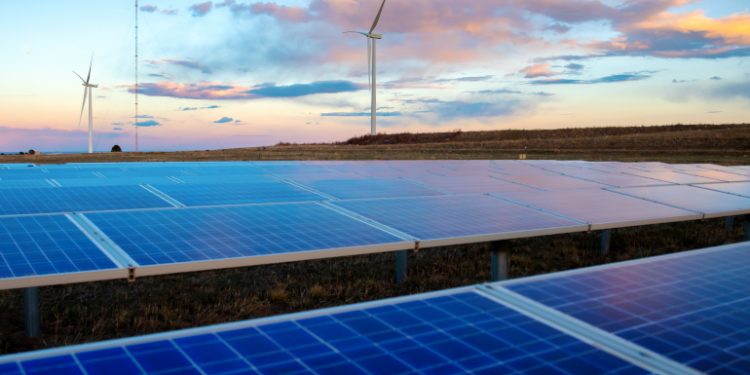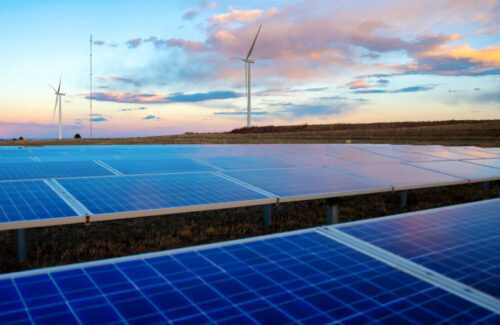Solar and wind accounted for almost 98% of new U.S. electrical generating capacity added in the first two months of the year, according to data released by the Federal Energy Regulatory Commission (FERC). Solar specifically accounted for nearly three-quarters of the new capacity in January and February. A review by the SUN DAY Campaign determined that February 2025 was the 18th month in a row that solar was the largest source of new capacity.
In its latest monthly “Energy Infrastructure Update” report, FERC says 39 “units” of solar totaling 1,514 MW were placed into service in February along with two units of wind (266 MW). Combined, they accounted for 95.3% of all new generating capacity added during the month. The balance was provided by natural gas (87 MW).
For the first two months of the year, renewables (6,309 MW) were 97.6% of new capacity while natural gas (147 MW) provided just 2.3% with another 0.2% coming from oil (11 MW).
Solar accounted for 81.1% of all new generating capacity placed into service in February. It was 73.3% of new capacity added during the first two months of 2025. Contributing to solar’s recent additions were the 237.3-MW Fence Post Solar Project in Texas as well as the 150-MW Northern Orchard Solar Project in California, the 135-MW Prairie Ronde Solar Project in Louisiana and the 120-MW Ross County Solar Project in Ohio.
Solar has now been the largest source of new generating capacity added each month for eighteen consecutive months: September 2023 through February 2025.
New wind accounted for most of the balance (14.3%) of capacity additions in February. New wind capacity (1,568 MW) added in January and February was 70% more than what was added during the same period a year earlier (922 MW). February’s new wind capacity consisted of the 140.3-MW Pioneer DJ Wind Project in Texas and the 126.0-MW Downeast Wind Project in Maine.
The installed capacities of solar (10.7%) and wind (11.8%) are now each more than one-tenth of the nation’s total. Taken together, they constitute almost one-fourth (22.5%) of the total available installed utility-scale generating capacity in the United States.
Moreover, approximately 30% of U.S. solar capacity is in the form of small-scale systems that is not reflected in FERC’s data. Including that additional solar capacity would bring the share provided by solar and wind to more than one-quarter of the nation’s total.
With the inclusion of hydropower (7.6%), biomass (1.1%) and geothermal (0.3%), renewables currently claim a 31.5% share of total U.S. utility-scale generating capacity. If small-scale solar capacity is included, renewables are now about one-third of total U.S. generating capacity.
For perspective, a year earlier the mix of utility-scale renewables accounted for 29.3% of total installed generating capacity. Five years ago, it was 22.6%. Ten years ago, it was 16.9% (with more than half provided by hydropower). Thus, over the past decade, renewables’ share of U.S. generating capacity has nearly doubled.
The mix of all utility-scale renewables is now adding about two percentage points each year to its share of generating capacity. At that pace, by March 1, 2028, renewables would account for 37.6% of total available installed utility-scale generating capacity — rapidly approaching that of natural gas (40.2%) — with solar and wind constituting more than three-quarters of the installed renewable energy capacity. If those trendlines continue, utility-scale renewable energy capacity should surpass that of natural gas in 2029 or sooner.
However, as noted, FERC’s data do not account for the capacity of small-scale solar systems. If that is factored in, within three years, total U.S. solar capacity (small-scale plus utility-scale) could approach 330 GW. In turn, the mix of all renewables would then exceed 40% of total installed capacity while natural gas’ share would drop to about 37%.
“The Trump Administration’s assault on wind and solar have not — at least not yet — had an appreciable impact on the rapid growth of renewable energy generating capacity,” noted the SUN DAY Campaign’s executive director Ken Bossong. “Moreover, if FERC’s current projections materialize, the mix of renewables will surpass natural gas capacity before the end of President Trump’s time in the White House.”
News item from SUN DAY

















